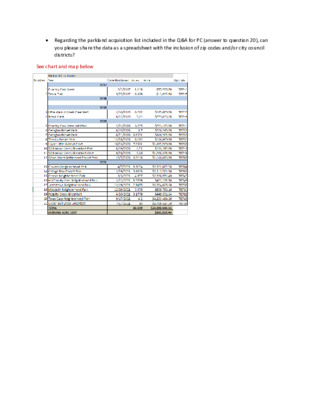10 Submitted by Commissioner Azhar - PC Commission Responses Commercial PLD 08042022.pdf — original pdf
Backup

• Regarding the parkland acquisition list included in the Q&A for PC (answer to question 20), can you please share the data as a spreadsheet with the inclusion of zip codes and/or city council districts? See chart and map below • In terms of the standard of 9.4 acres for every thousand residents, can you please share what standards do other peer cities employ in terms of acreage for every thousand residents? (Peer cities may include Dallas, Houston, Denver, San Diego, Portland) Other cities vary in the level of service required by parkland dedication and/or park impact fees. San Diego ranges across different types (single family, multi family, and accessory) and different planning areas in the city: 165.96 square feet of parkland per unit to 544.94 square feet of parkland per unit – equal to an approximate equivalent of 2.24 acres per 1,000 people to 7.36 acres per 1,000 people. Madison, WI has 10.13 acres per 1,000 people. Dallas ranges from 1 acre per 100 single family homes to 1 acre per 255 multifamily homes; that ranges from an equivalent 3.57 acres per 1,000 people to 2.3 acres per 1,000 people. Minneapolis requirements are 287.5 square feet per every downtown dwelling unit, and 435.6 square feet per dwelling unit outside downtown; that would equate to roughly 3.88 per 1,000 people to 4.55 acres per 1,000 people. Atlanta’s level of service—including commercial--range from 17.07 acres to 2.83 acres for every 1,000 functional population; range is based on region, and discounts are applied to the functional population calculation depending on density Dr. John R Crompton’s studies have documented the requirements across Texas in his study “Parkland Dedication: An Underutilized Resource”, published this year (see attached, page 36-38 includes a table summarizing the requirements across Texas). For further reference, the National Recreation and Park Association (NRPA) states that the typical park service is 9.9 acres per 1,000 people. The 2017 Trust for Public Land City Parks Facts report also includes a table with acres per 1,000 people in all major cities in US: Austin has an established goal of 24 park acres per 1,000 residents. Currently, Austin declined to 18 acres per 1,000, as the city has grown. Parkland dedication is intended to help maintain the park level of service; as such, it is currently set to 9.4 acres per 1,000 people, which was calculated using the acreage of pocket parks, neighborhood parks, and greenbelts at the time of the 2014 parkland dedication study. The parkland dedication formula is required to address the impact of the new population on the existing park services. In terms of the standard of 9.4 acres for every thousand residents, can you please share national standards and best practices in this regard? (literature from Dr. John Crompton was mentioned in the meeting, perhaps you can share any literature on standards that he has) We have attached two studies by Dr. Crompton: his most recent, “Parkland Dedication: An Underutilized Resource” (2022), and “Parkland Dedication Ordinances in Texas: A Missed Opportunity?” (2015). Dr. Crompton concludes that the best practice is to fix the requirement to the costs of acquiring and developing parkland, as well as establish required levels of service that “incorporate a methodology or calculations showing how this standard was derived”. Generally, required acreages that are not fixed to a goal or established level of service may be considered arbitrary, as they are not proportional to development’s impact to a city’s parks system. For Austin, the City’s goal is 24 acres per 1,000 people, as established by PARD’s Key Performance Indicator, Imagine Austin, and PARD’s Long Range Plan. This goal was historically the minimum level of service the city enjoyed until approximately 2005, as shown in the 2014 study. In 2014, the level of service would have been around 20 acres per 1,000. To derive the current parkland dedication requirement, the acreages of metro parks, district parks, and golf courses were subtracted from the then-current level of service, as they are regional facilities typically funded through citywide bond funds. Parkland dedication is meant to mitigate the localized impact of new residents on the parks system with neighborhood and pocket parks, which have ¼- and ½-mile service areas. As such, metro parks, district parks, and golf courses were excluded from the target, which yielded 9.4 acres per 1,000 people. As such, Austin is meeting best practices by having the requirement tied to a measurable goal based on historic levels of parks service. •